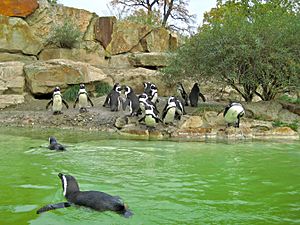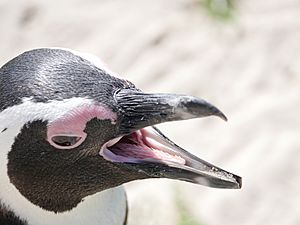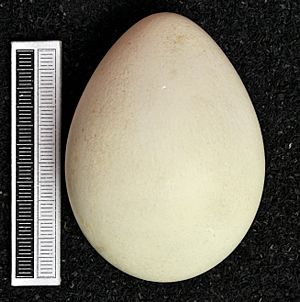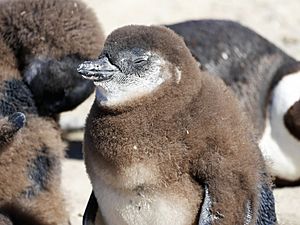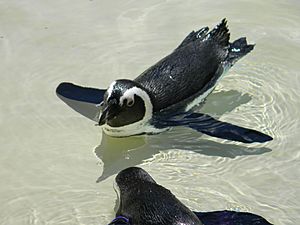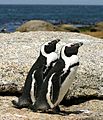African penguin facts for kids
Quick facts for kids African penguin |
|
|---|---|
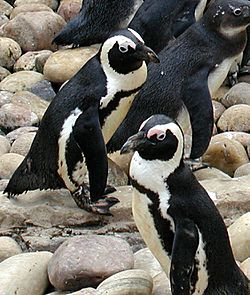 |
|
| Conservation status | |
| Scientific classification | |
| Kingdom: | |
| Subphylum: | |
| Class: | |
| Order: | |
| Family: | |
| Genus: |
Spheniscus
|
| Binomial name | |
| Spheniscus demersus (Linnaeus, 1758)
|
|
The African penguin (Spheniscus demersus), also known as the Cape penguin, and South African penguin, is a species of penguin confined to southern African waters. Like all extant penguins, it is flightless, with a streamlined body, and wings stiffened and flattened into flippers for a marine habitat.
The African penguin is a pursuit diver and feeds primarily on fish and squid. Once extremely numerous, the African penguin is declining rapidly due to a combination of several threats and is classified as endangered.
The closest relatives of the African Penguins are the Humboldt and Magellanic penguins found in southern South America and the Galápagos Penguin found in the Pacific Ocean near the equator.
Contents
Description
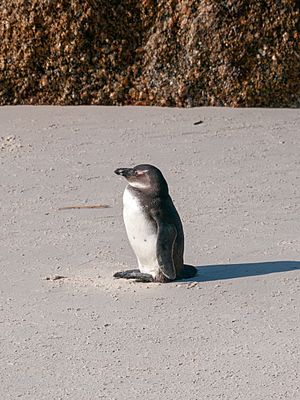
African penguins grow to 60–70 cm (24–28 in) tall and weigh between 2.2–3.5 kg (4.9–7.7 lb).
They have a black stripe and black spots on the chest, the pattern of spots being unique for every penguin, like human fingerprints. They have pink glands above their eyes, which are used for thermoregulation. The hotter the penguin gets, the more blood is sent to these glands so it may be cooled by the surrounding air, thus making the glands more pink.
The males are larger than the females and have larger beaks. Juveniles do not possess the bold markings of the adult but instead have dark upper-parts that vary from greyish-blue to brown; the pale underparts lack both spots and the band.
The beak is more pointed than that of the Humboldt. Their distinctive black and white colouring is a vital form of camouflage called countershading– white for underwater predators looking upwards and black for predators looking down onto the dark water.
Other names of the species include black-footed penguin and jackass penguin, which it is called due to its loud donkey-like bray.
Distribution and habitat
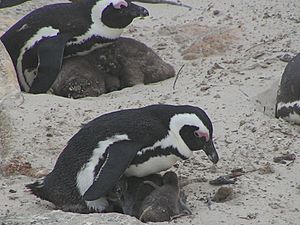
The African penguin is only found on the south-western coast of Africa, living in colonies on 24 islands between Namibia and Algoa Bay, near Port Elizabeth, South Africa. It is the only penguin species that breeds in Africa and its presence gave name to the Penguin Islands.
Two colonies were established by penguins in the 1980s on the mainland near Cape Town, namely Boulders Beach near Simon's Town and Stony Point in Betty's Bay. Mainland colonies probably only became possible in recent times due to the reduction of predator numbers, although the Betty's Bay colony has been attacked by leopards. The only other mainland colony is in Namibia, but it is not known when it was established.
Boulders Beach is a tourist attraction, for the beach, swimming and the penguins. The penguins will allow people to approach them as close as a metre.
Breeding populations of African penguins are being kept in numerous zoos worldwide. No colonies are known outside the south-western coast of Africa, although vagrants (mostly juveniles) may occasionally be sighted beyond the normal range.
Population
Roughly 4 million penguins existed at the beginning of the 19th century. Of the 1.5-million population of African penguins estimated in 1910, only some 10% remained at the end of the 20th century. African penguin populations, which breed in Namibia and South Africa, have declined by 95 percent since pre-industrial times.
The total population fell to 200,000 in 2000. In 2010, the number was estimated to be only at 55,000. If this decline is not halted, the African penguin is expected to be extinct within 15 years.
5,000 breeding pairs were estimated to live in Namibia in 2008; in 2012, about 18,700 pairs were estimated to live in South Africa, with the majority of those numbers on St Croix Island in Algoa Bay.
Behaviour
Diet
African penguins forage in the open sea, where they pursue pelagic fish such as pilchards and anchovies (e.g. Engraulis capensis), and marine invertebrates such as squid and small crustaceans. Penguins normally swim within 20 km of the shore. A penguin may consume up to 540 grams of prey every day, but this may increase to over 1 kg when raising older chicks.
Due to the collapse of a commercial pilchard fishery in 1960, African penguin diet has shifted towards anchovies. While a diet of anchovy appears to be generally sufficient, it is not ideal due to lower concentrations of fat and protein.
Penguin diet changes throughout the year; as in many seabirds, it is believed that the interaction of diet choice and breeding success helps the penguins maintain their population size. Although parent penguins are protective of their hatchlings, they will not sustain nutritional deficits themselves if prey is scarce and hunting requires greater time or energy commitment. This may lead to higher rates of brood loss under poor food conditions.
Breeding
The African penguin is monogamous. It breeds in colonies, and pairs return to the same site each year. The African penguin has an extended breeding season, with nesting usually peaking from March to May in South Africa, and November and December in Namibia. African penguin females remain fertile for 10 years. African penguins spend most of their lives at sea until it comes time for them to lay their eggs.
A clutch of two eggs are laid either in burrows dug in guano, or scrapes in the sand under boulders or bushes. Incubation is undertaken equally by both parents for about 40 days. At least one parent guards the chicks until about 30 days, where after the chick joins a crèche with other chicks, and both parents head out to sea to forage each day.
Chicks fledge at 60 to 130 days, the timing depending on environmental factors such as quality and availability of food. The fledged chick then go to sea on their own and return to their natal colony after a lengthy time period of 12–22 months to molt into adult plumage.
When penguins molt, they are unable to forage as their new feathers are not waterproof yet; therefore they don't eat over the entire molting period, which in African penguins takes about 20 days.
Predation

The average lifespan of an African penguin is 10 to 27 years in the wild, and can live up to 30 in captivity. However, the African penguin may often fall to predators.
Predators in the ocean include sharks, Cape fur seals and, on occasion, orcas. Land-based enemies include mongooses, genets, caracals, leopards, domestic cats, and the kelp gull which steals their eggs and newborn chicks.
Pressure from terrestrial predators is higher if penguins are forced to breed in the open in the absence of suitable burrows or nest boxes.
Threats and conservation
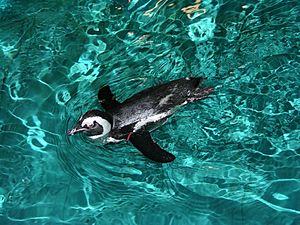
As recently as the mid-20th century, penguin eggs were considered a delicacy and were still being collected for sale. Unfortunately, the practice was to smash eggs found a few days prior to gathering, to ensure that only fresh ones were sold. This added to the drastic decline of the penguin population around the Cape coast, a decline which was hastened by the removal of guano from islands for use as fertiliser, eliminating the burrowing material used by penguins.
Penguins remain susceptible to pollution of their habitat by petrochemicals from spills, shipwrecks and cleaning of tankers while at sea.
Commercial fisheries of sardines and anchovy, which are the two main prey species of the penguins, have forced these penguins to search for prey farther off shore, as well as having to switch to eat less nutritious prey.
The African penguin is one of the species to which the Agreement on the Conservation of African–Eurasian Migratory Waterbirds (AEWA) applies. In November 2013 the African penguin was listed as endangered on the IUCN Red List of Threatened Species. In September 2010 it was listed as endangered under the US Endangered Species Act.
Images for kids
-
African penguin skeleton at the Museum of Osteology in Oklahoma City, Oklahoma, USA
-
African penguin at the Dallas World Aquarium, Dallas, Texas, United States
See also
 In Spanish: Pingüino de El Cabo para niños
In Spanish: Pingüino de El Cabo para niños



